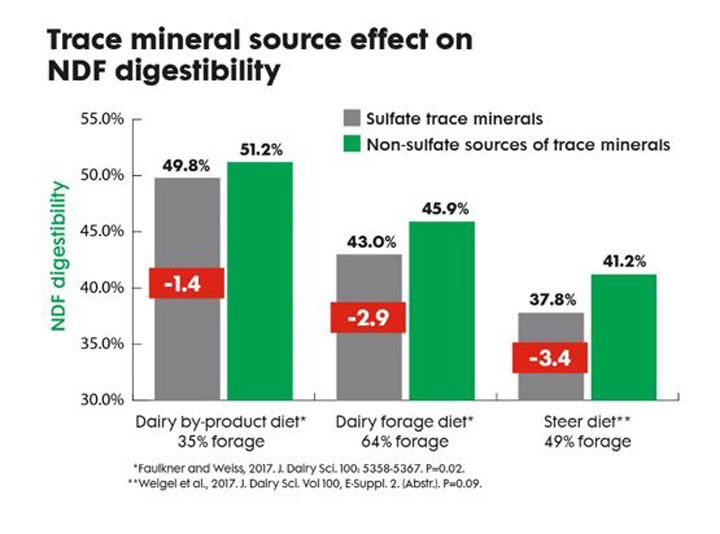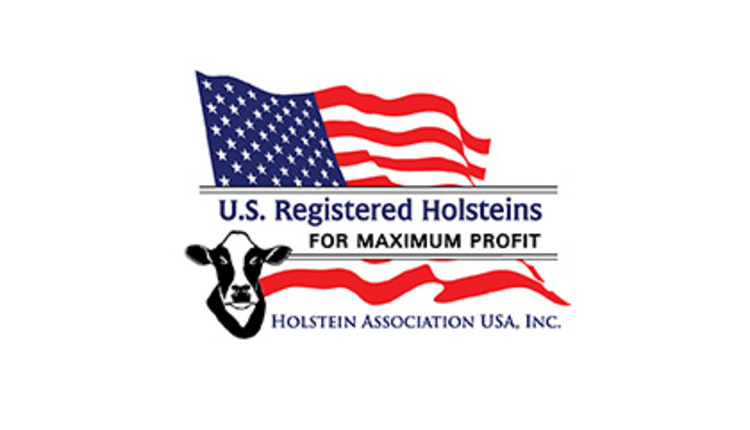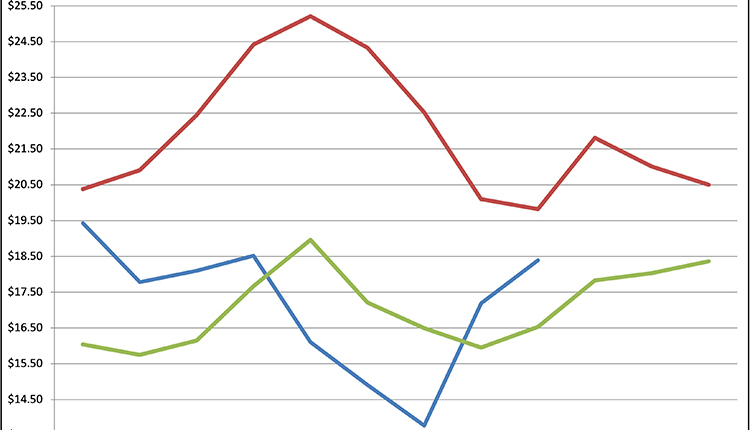The information below has been supplied by dairy marketers and other industry organizations. It has not been edited, verified or endorsed by Hoard’s Dairyman. 

Rumen microbes are integral to the digestion of fiber in the dairy ration, producing volatile fatty acids that support cows’ energy and milk production. Research commissioned by Micronutrients finds that the longstanding practice of including sulfate trace minerals in the dairy ration may actually do more harm than good. The findings are prompting many animal nutritionists across the nation to rethink the inclusion of sulfate trace minerals and consider alternative strategies.
Three Areas of Concern Surrounding Sulfates
According to Dr. Scott Fry, Director of Technical Sales Support at Micronutrients, the research findings point to three key concerns about sulfate trace minerals in the dairy ration. The first area of concern relates to sulfate trace minerals’ high reactivity. Following ingestion, the weak bonds of sulfate trace minerals dissociate easily, thus releasing free metals into the cow’s rumen. The free metals can bind with antagonists and reduce the availability of sulfate trace minerals in the small intestine. A second area of concern is that free metals in the rumen can cause harm to rumen microbes, potentially killing beneficial microbe populations. Finally, compared to cows fed less reactive trace minerals, cows fed sulfate trace minerals show a decrease in neutral detergent fiber digestion (NDFD). In controlled research studies, fiber digestibility in cattle receiving sulfate trace minerals was decreased by 1.4 to 3.4 points, compared to cows receiving non-sulfate sources of trace minerals (Figure 1). Given the important role microbes play in fiber digestion, Micronutrients’ research suggests that harm from free metal released by sulfate trace minerals in the ration can reduce NDFD.
At a time when cow production efficiency and performance are critical, research suggests that producers using sulfate trace minerals in their ration may be paying for a supplement that negatively impacts NDFD. “The research demonstrates that the longstanding practice of supplementing the ration with sulfates could actually be doing more harm than good,” noted Dr. Fry.
 (Above) In two studies, cattle receiving sulfate trace minerals in their feed showed a decrease in fiber digestibility of 1.4 to 3.4 points, compared to cattle receiving non-sulfate sources of trace minerals.
(Above) In two studies, cattle receiving sulfate trace minerals in their feed showed a decrease in fiber digestibility of 1.4 to 3.4 points, compared to cattle receiving non-sulfate sources of trace minerals.
About Micronutrients: Based in Indianapolis, Indiana, Micronutrients is a global mineral feed ingredient producer focused on developing, manufacturing and marketing a full range of quality trace minerals. Micronutrients is the market leader for hydroxy trace minerals which are marketed under the global brand name IntelliBond®. Hydroxy trace minerals are specialty trace minerals that, due to their unique chemical structure, improve stability of premixes and feeds.
According to Dr. Scott Fry, Director of Technical Sales Support at Micronutrients, the research findings point to three key concerns about sulfate trace minerals in the dairy ration. The first area of concern relates to sulfate trace minerals’ high reactivity. Following ingestion, the weak bonds of sulfate trace minerals dissociate easily, thus releasing free metals into the cow’s rumen. The free metals can bind with antagonists and reduce the availability of sulfate trace minerals in the small intestine. A second area of concern is that free metals in the rumen can cause harm to rumen microbes, potentially killing beneficial microbe populations. Finally, compared to cows fed less reactive trace minerals, cows fed sulfate trace minerals show a decrease in neutral detergent fiber digestion (NDFD). In controlled research studies, fiber digestibility in cattle receiving sulfate trace minerals was decreased by 1.4 to 3.4 points, compared to cows receiving non-sulfate sources of trace minerals (Figure 1). Given the important role microbes play in fiber digestion, Micronutrients’ research suggests that harm from free metal released by sulfate trace minerals in the ration can reduce NDFD.
At a time when cow production efficiency and performance are critical, research suggests that producers using sulfate trace minerals in their ration may be paying for a supplement that negatively impacts NDFD. “The research demonstrates that the longstanding practice of supplementing the ration with sulfates could actually be doing more harm than good,” noted Dr. Fry.
Alternatives to Sulfates in the Dairy Ration
Given concerns surrounding sulfate trace minerals, many producers are considering three alternative paths forward. Producers can include all organic trace minerals in their ration, include all hydroxy trace minerals in the ration, or use a blended approach of hydroxy and organic trace minerals to optimize performance and economics.
Given concerns surrounding sulfate trace minerals, many producers are considering three alternative paths forward. Producers can include all organic trace minerals in their ration, include all hydroxy trace minerals in the ration, or use a blended approach of hydroxy and organic trace minerals to optimize performance and economics.

About Micronutrients: Based in Indianapolis, Indiana, Micronutrients is a global mineral feed ingredient producer focused on developing, manufacturing and marketing a full range of quality trace minerals. Micronutrients is the market leader for hydroxy trace minerals which are marketed under the global brand name IntelliBond®. Hydroxy trace minerals are specialty trace minerals that, due to their unique chemical structure, improve stability of premixes and feeds.





